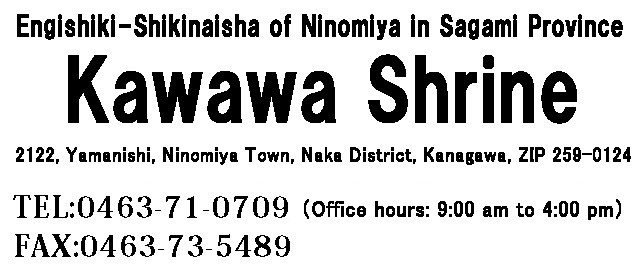Enshrined Gods
Onamuji no Mikoto |
The god who cultivated the land of Japan | Play video for details in Japanese |
|
| Omonoimi no Mikoto | The god who contributed to promoting industry growth | Play video for details in Japanese |
|
| Shinatsuhiko no Mikoto | The god and goddess of Winds and Breath The married couple of gods who cultivated Shinaga Region (western part of Kanagawa Prefecture, west of Sagami River) |
Play video for details in Japanese |
|
| Shinatsuhime no Mikoto | |||
| Sotohorihime no Mikoto | The wonder-working goddess for safe childbirth | Play video for details in Japanese |
Distinguished History
It was established under the imperial command in the era of the 11th Emperor of Japan, Emperor Suinin (approximately 2000 years ago), by someone called Ayahano Miyatsuko, the regional administrator of Shinaga (similar to a modern prefectural governor) in order to safeguard the Shinaga Region (now known as the western part of Kanagawa Prefecture). Yamato Takeru no Mikoto made a consecration prayer here in the middle of his eastern expedition. The shrine began to pray for safe childbirth by consecrating Sotohorihime no Mikoto, the consort of the 19th emperor of Japan, Emperor Ingyo. Minamoto no Yoritomo made an offering of a sacred horse to pray for safe childbirth in Kenkyu 3 (1192). It has been strongly revered by the Odawara Hojo clan as the guardian shrine for safeguarding their kimon (northeastern quarter that is unlucky). When the shrine offered a kitofuda (blessed talisman) to Shogun Tokugawa Ieyasu, who was about to depart for the front to Nagoya in Kyushu, he was so much pleased that he gave it Shuinchi (shrine's territory authorized by the Edo shogunate) having a production of 50 koku (of crop yield). Since then, permission was granted to keep their Shuinchi by the successive generations of Tokugawa shoguns. It also became the custom for the successive generations of the chief priests to take the name of "Futami Jintaro" and always appear at Edo Castle on New Year to perform greetings and offer a purified talisman. This continued until the end of the Edo period, and it became listed as a gosha (village shrine) in 1873. In the first year of the Eien era (987 AD), Fujiwara Kagehira, the second son of Awada Chunagon (vice-councilor of state), became the first chief priest and took on the family name "Futami", and the bloodline has since continued for 1200 years up until the present day, with the current chief priest Futami marking the 41st generation. The site is 2,000 tsubo (approximately 6,612 square meters), surrounded by forests in all directions, and is a quiet, sacred and spiritual place. The main treasures preserved at the shrine include: Amiishi, a stone used to weigh down fishing nets for the ritual for praying for rain, which was brought in by the first chief priest of the Futami family from Ise Futamigaura, Mie Prefecture; Zuishinzo, the statues of gatekeeper guards at the thatched shrine gate, which are the oldest that can be found in Kanagawa Prefecture (dating from the late Heian period); Tabune, a rice and soil carrier for use in wet fields, which was discovered in the old shrine grounds; Kochizu, an antique map of the Kamisoroiyama ceremony site for Kounomachi (Provincial Capital Festival) (dating from the middle of the Edo period); and Toriigaku, a torii plaque with the handwriting of Prince Ito Hirobumi, the first prime minister of Japan. Many other ancient documents and records are also preserved here. |
Treasured Items Owned by the Shrine
